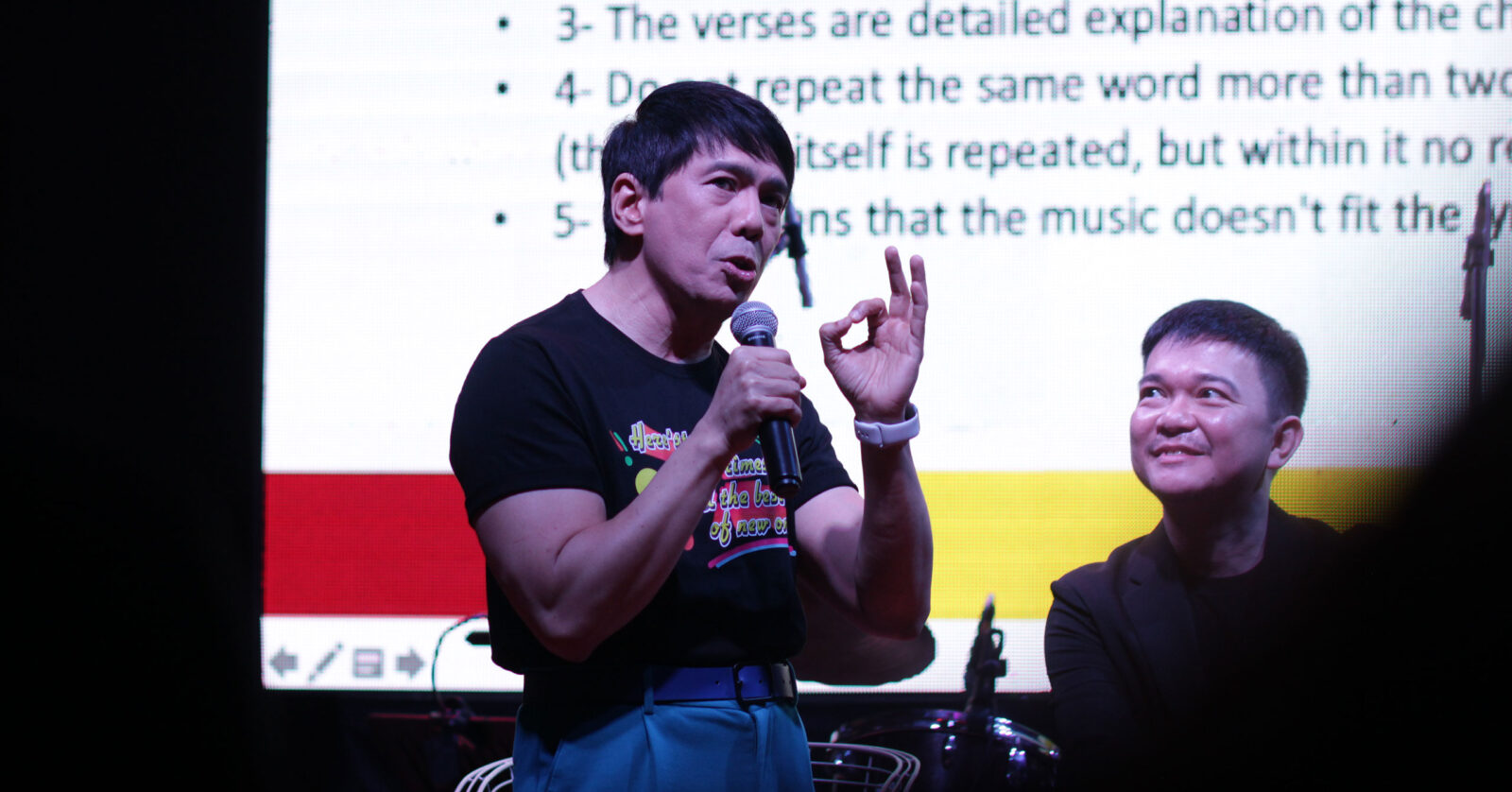Songwriting 101: How To Write A Song From Scratch, As Learned From Trina Belamide, Jonathan Manalo, And Moy Ortiz
Learn how to make a song from start to finish.

Ortiz, Belamide, Manalo: Courtesy of Bonifacio Art Foundation, Inc.
Ortiz, Belamide, Manalo: Courtesy of Bonifacio Art Foundation, Inc.
A blank page is either the most intimidating or most inspiring thing that could confront a writer.
Although it’s a matter of perspective, songwriters know all too well that the next big hit is not going to write itself. Fortunately, there are practical steps that songsmiths can take to heart before coming up with new music.
Here is a masterclass on songwriting made from the industry wisdom shared by hitmakers Trina Belamide, Jonathan Manalo, and Moy Ortiz, who were all part of the workshop “Filipino Songwriting: From Dreams to Sheet,” at the recently concluded Pinoy Playlist Music Festival (PPMF) 2023. Check out some of the lessons we’ve learned from them below.
Breaking down the music

Manalo: Courtesy of Bonifacio Art Foundation, Inc.
According to Manalo, a song is basically a combination of words and music. An effective one would need to have both great lyrics and great music.
“Great lyrics are simply a mix of easy nice words revolving around an interesting topic that you want write about. As per great music, you will have to create a complicated masterpiece,” Manalo said.
In the context of pop songwriting, he reassured the audience that great music means only a simple but very catchy melody.
“Now we got music and lyrics, but that means nothing if a catchy melody and a number of nice words were just scattered all over your song. Music and lyrics need to be put in a concrete song structure,” the multi-award-winning hitmaker explained.
Basic song structures are usually any combination of three short melodies, including two that are repeated over and over again. These two are the verse (story builder) and the chorus (hook). Lastly, a song usually culminates into a bridge (climax builder) that has a nonrepeating distinct sound compared to the earlier melodies.
“The chorus is where the hook is. So when we write songs ‘yung pinaka-memorable [the most memorable] part ng kanta ay nandoon palagi sa [of the song is always found in the] chorus… Sometimes meron rin tinatawag na [there is a so-called] pre-chorus or what we call a ‘climb.’ Para siyang ‘yung naghahatid papuntang chorus. [It is like what builds up toward the chorus.] And then the bridge is a separate section para umangat lalo ‘yung kanta [so the song can progress higher],” Belamide introduced.
She demonstrated this simple music theory with her award-winning song “Shine,” which has been performed by the likes of Regine Velasquez and Morissette. While playing on a piano in a lower key that she can sing, Belamide showed how simple structures underlie the hits around us.
“So, you notice how the chorus has a lot of repetition in it, because that’s where the hook needs to be. Even if you never heard this before can you guess what the title is? ‘Shine,’ yes. We like to put the title in the chorus, because the chorus is the meatiest part of the song,” Belamide revealed.
Altogether, according to Ortiz, the song has to have lift: “‘Yung verse parang maliit na ilog. [The verse is like a small river.] Tapos papunta ka na sa [And then you proceed to the] pre-chorus, lumalaki ‘yung ilog [the river grows]. Pagkadating mo sa [Come the] chorus, where all of the beautiful melodic hooks are, it should feel like you’re opening up to an ocean. And you should feel the lift.”
Finding the words

Ortiz, Manalo: Courtesy of Bonifacio Art Foundation, Inc.
As for the lyrics, Manalo reassured songwriters that the process is not as complicated as poetry.
“Poetry has lots of word rules, it is simply a language game that has nothing to do with music. Lyrics on the other hand, have everything to do with music and it is more important for good lyrics to fit the music nicely and neatly than to have amazing metaphors or glamourous word combinations,” he analyzed.
Nonetheless, the lyrics must discuss an interesting topic in order to be relatable. The chorus is a general explanation of the said topic, while the verses go into more detail with the storytelling.
“It’s basic rules, when you know the rules well, you can break it. Do not repeat the same word more than two or three times max in a verse or chorus. The chorus itself is repeated, but we limit. No repetition allowed. If it happens that the music doesn’t fit the lyrics neatly, alter the lyrics not the music,” Manalo advised.
On a practical level, one of the primary considerations for writing lyrics is that the end of lines must rhyme to some extent with succeeding ones.
“Lyrics that rhyme are the most memorable and the easiest to fit in the music vehicle nicely. But take care, rhyming too much sounds stupid and keep in mind that rhyme comes second to meaning… So, don’t just rhyme your lyrics for the sake of rhyming it,” Manalo suggested.
Personally, he finds the process much easier because he can simply search online for what words rhyme with one another through platforms like RhymeZone.
Belamide similarly works smart when trying to find rhymes that make sense when sung.
“Sometimes, I start with the end and work it backward… So if I wanted to end with ‘tell the word of his love,’ I looked for a word that rhymed with love… ‘Above.’ Ay above pwede parang heaven ganyan [Oh above similar to something like heaven]. So it was very purposeful and deliberate to use above right before that line,” she celebrates.
But what goes first, the music or the lyrics? It’s no chicken-and-egg situation for Belamide, who explains that the music is just as important as the lyrics. Sometimes, all it takes is a catchy melody.
“Music is a universal language. You know admittedly there are some hits whose lyrics don’t make sense, but the music is so catchy. As much as I would be careful, importante din ang lyrics,” she nuances.
Ortiz added that making a song is similar to making a personal impression for the first time. Music is the physical appearance of the person whereas lyrics are the personality. While both are necessary, it is the music that one notices first.
“It’s just about knowing a person or stranger for the first time. ‘Yung unang tingin mo sa kaniya, siyempre [Upon your first look, of course] you’re attracted by the physical aspect of the person na parang, ‘Uy attractive siya [like, ‘Oh they’re attractive’].’ People compare that to the melody because that’s the first flush of infatuation na ‘Ay ang ganda [Oh they’re beautiful],’” he concludes.
“When you know the person deeper, when you know the song deeper because of what the song says, that’s a nice analogy.”